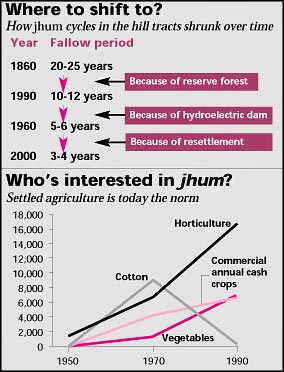Don t blame it on Jhum
 The 13, 295 sq km Chittagong Hill Tracts in Bangladesh, about 52 per cent of its forest land, are hot spots for jhum practice. Land degradation in the area has, as in India, very often been blamed on it. But Golam Rasul, environment scientist from Bangaldesh, set the record straight at the meeting in Shillong.
The 13, 295 sq km Chittagong Hill Tracts in Bangladesh, about 52 per cent of its forest land, are hot spots for jhum practice. Land degradation in the area has, as in India, very often been blamed on it. But Golam Rasul, environment scientist from Bangaldesh, set the record straight at the meeting in Shillong.
He shows that jhum began to get marginalised, and degradation of land & forest set in, with the creation of reserve forests by the colonial government. The situation became worse after the nationalisation of lands and forests, and aggravated by the construction of the Kaptai Hydroelectric dam in Rangamati in 1960: the best agricultural land of the area went under the waters of the artificially created 655 sq km lake; as many as 100,000 people were uprooted from their ancestral homes. Rasul notes that past and present polices failed to create a conducive environment for jhum, quite as in India.
However, there remain some exceptions. In a few areas where farmers still have land titles and access to market and support services, they have adopted horticulture, agroforestry, tree farming and other locally suitable land use systems.
Marginalised
Why jhum is disappearing from the Chittagong Hill Tracts in Bangladesh | | Major policy changes | Impact on jhum (shifting cultivation) | • 1960 Hydroelectric project
• Inundated 40 per cent of valley land
• Displaced 20,000 families, 50 per cent of them plough cultivators
• Abolishing special status of Chittagong Hill Tracts
• Jhumia Rehabilitation Program
• Industrial use of forest products
• Planned resettlement of plain land people into the Chitaagong Hill Tracts
• Expanding reserve forest. In 1992, government declared 50,000 ha as reserve forest
• More than 4000 ha allocated for rubber
plantations | • Number of jhumia increased
• Jhum expanded to marginal land and reserve forests
• Industrialisation provided little employment opportunities to jhumia
• Pressure on land increased severely
• Jhum yield declined
• Plain land people increased heavily
• Pressure on land increased severely
• Most migrants are settled in government ‘khash’ land, community land previously used used for shifting cultivation
• Many shifting cultivators forced to move further uphill | |
Related Content
 The 13, 295 sq km Chittagong Hill Tracts in Bangladesh, about 52 per cent of its forest land, are hot spots for jhum practice. Land degradation in the area has, as in India, very often been blamed on it. But Golam Rasul, environment scientist from Bangaldesh, set the record straight at the meeting in Shillong.
The 13, 295 sq km Chittagong Hill Tracts in Bangladesh, about 52 per cent of its forest land, are hot spots for jhum practice. Land degradation in the area has, as in India, very often been blamed on it. But Golam Rasul, environment scientist from Bangaldesh, set the record straight at the meeting in Shillong. 